Page 2338 of 2890
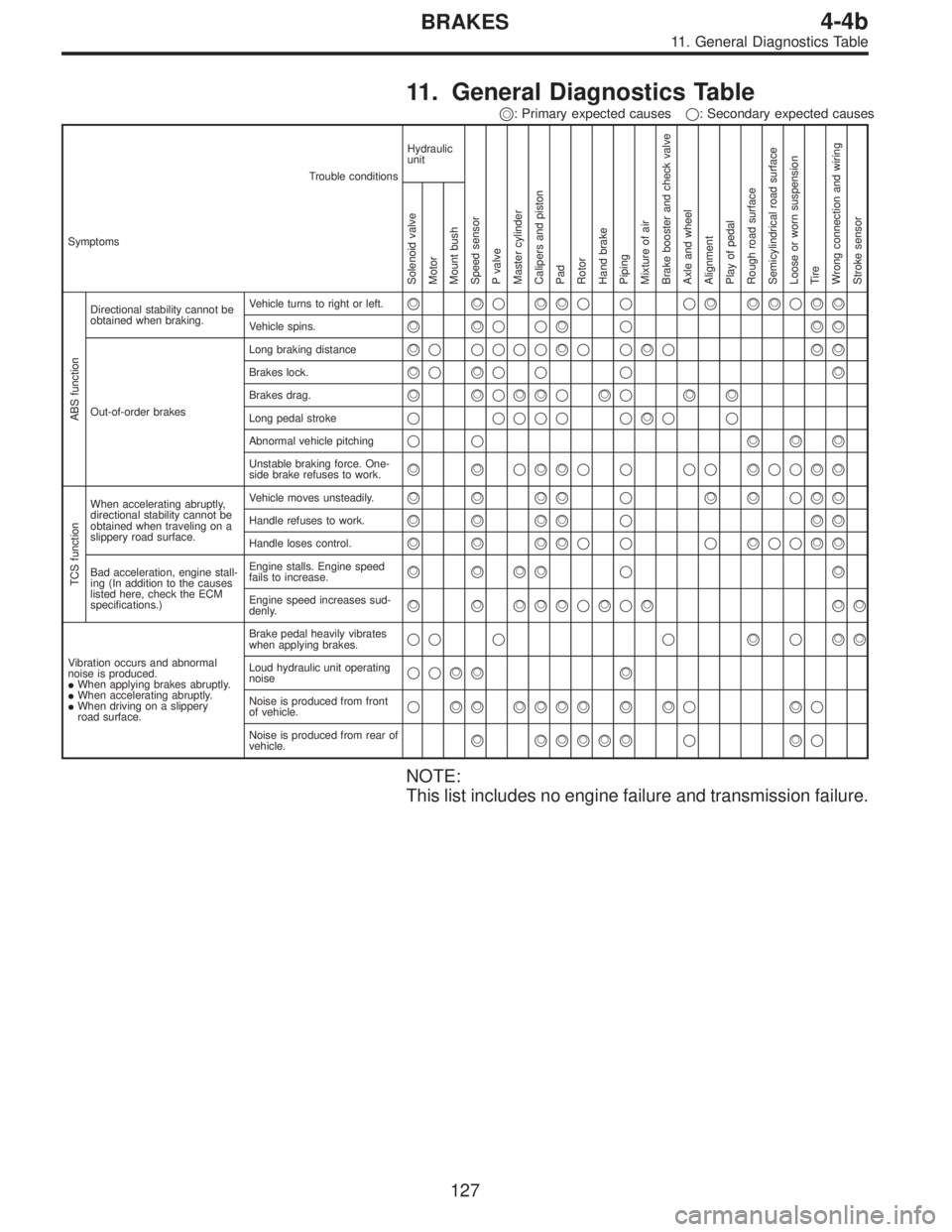
11. General Diagnostics Table
��: Primary expected causes�: Secondary expected causes
Trouble conditions
SymptomsHydraulic
unit
Speed sensor
P valve
Master cylinder
Calipers and piston
Pad
Rotor
Hand brake
Piping
Mixture of air
Brake booster and check valve
Axle and wheel
Alignment
Play of pedal
Rough road surface
Semicylindrical road surface
Loose or worn suspension
Tire
Wrong connection and wiring
Stroke sensor Solenoid valve
Motor
Mount bush ABS function
Directional stability cannot be
obtained when braking.Vehicle turns to right or left.����������� ������������
Vehicle spins.�������������
Out-of-order brakesLong braking distance
��� ���������������
Brakes lock.������� � ��
Brakes drag.�����������������
Long pedal stroke� ���� �����
Abnormal vehicle pitching�� ������
Unstable braking force. One-
side brake refuses to work.����������� ����������
TCS function
When accelerating abruptly,
directional stability cannot be
obtained when traveling on a
slippery road surface.Vehicle moves unsteadily.������������������
Handle refuses to work.�������������
Handle loses control.���������� ���������
Bad acceleration, engine stall-
ing (In addition to the causes
listed here, check the ECM
specifications.)Engine stalls. Engine speed
fails to increase.�����������
Engine speed increases sud-
denly.��������������������
Vibration occurs and abnormal
noise is produced.
�When applying brakes abruptly.
�When accelerating abruptly.
�When driving on a slippery
road surface.Brake pedal heavily vibrates
when applying brakes.
�� � � �������
Loud hydraulic unit operating
noise��������
Noise is produced from front
of vehicle.���������������������
Noise is produced from rear of
vehicle.����������������
NOTE:
This list includes no engine failure and transmission failure.
127
4-4bBRAKES
11. General Diagnostics Table
Page 2340 of 2890
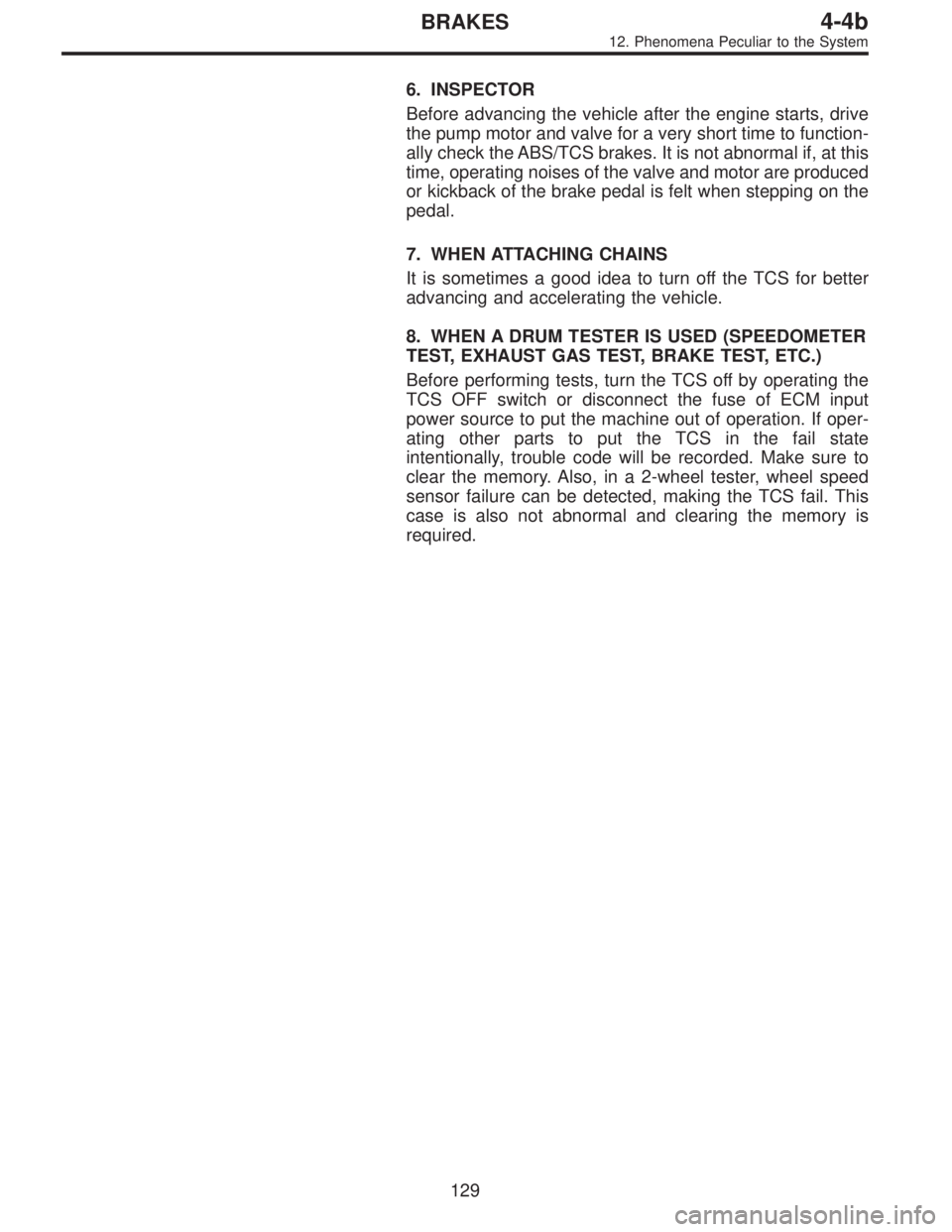
6. INSPECTOR
Before advancing the vehicle after the engine starts, drive
the pump motor and valve for a very short time to function-
ally check the ABS/TCS brakes. It is not abnormal if, at this
time, operating noises of the valve and motor are produced
or kickback of the brake pedal is felt when stepping on the
pedal.
7. WHEN ATTACHING CHAINS
It is sometimes a good idea to turn off the TCS for better
advancing and accelerating the vehicle.
8. WHEN A DRUM TESTER IS USED (SPEEDOMETER
TEST, EXHAUST GAS TEST, BRAKE TEST, ETC.)
Before performing tests, turn the TCS off by operating the
TCS OFF switch or disconnect the fuse of ECM input
power source to put the machine out of operation. If oper-
ating other parts to put the TCS in the fail state
intentionally, trouble code will be recorded. Make sure to
clear the memory. Also, in a 2-wheel tester, wheel speed
sensor failure can be detected, making the TCS fail. This
case is also not abnormal and clearing the memory is
required.
129
4-4bBRAKES
12. Phenomena Peculiar to the System
Page 2341 of 2890
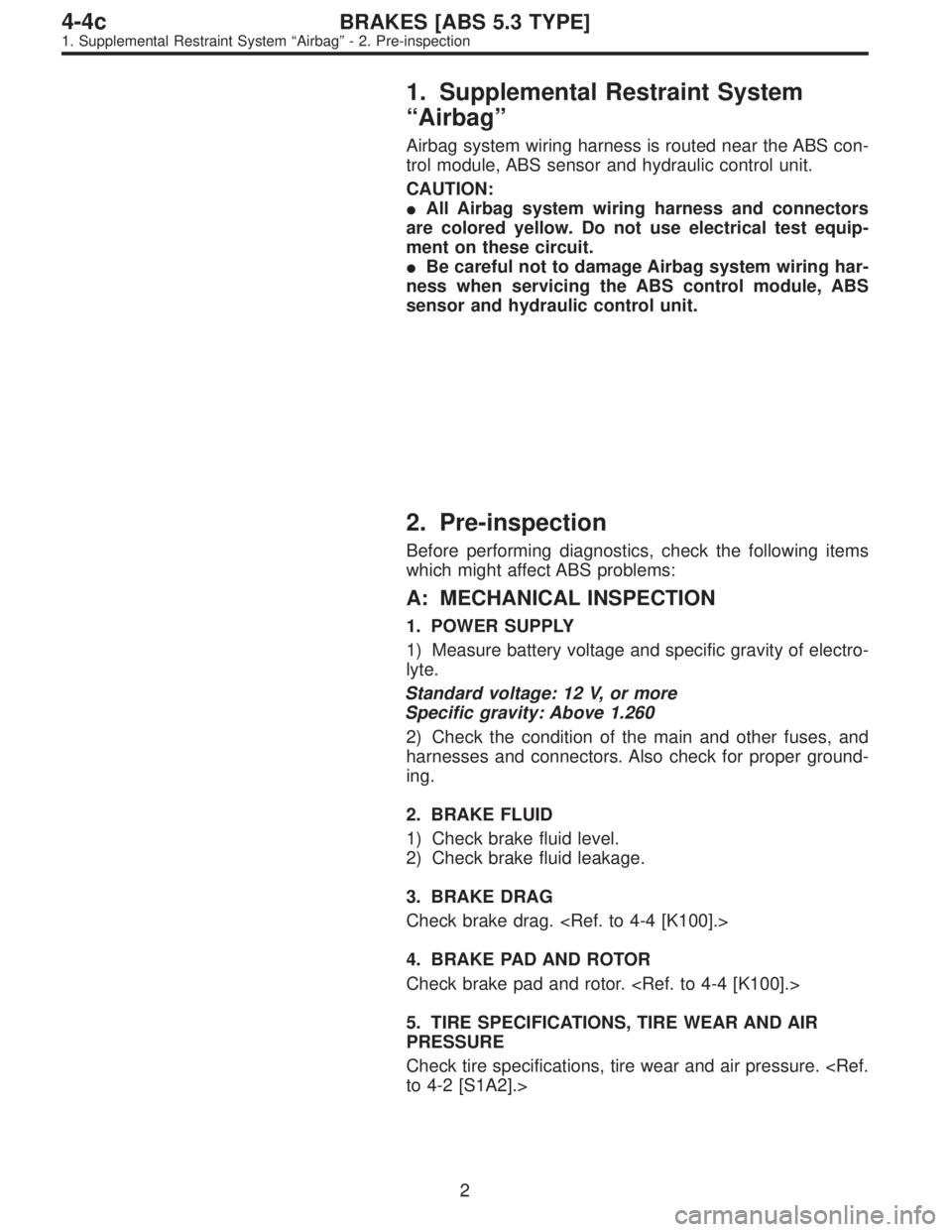
1. Supplemental Restraint System
“Airbag”
Airbag system wiring harness is routed near the ABS con-
trol module, ABS sensor and hydraulic control unit.
CAUTION:
�All Airbag system wiring harness and connectors
are colored yellow. Do not use electrical test equip-
ment on these circuit.
�Be careful not to damage Airbag system wiring har-
ness when servicing the ABS control module, ABS
sensor and hydraulic control unit.
2. Pre-inspection
Before performing diagnostics, check the following items
which might affect ABS problems:
A: MECHANICAL INSPECTION
1. POWER SUPPLY
1) Measure battery voltage and specific gravity of electro-
lyte.
Standard voltage: 12 V, or more
Specific gravity: Above 1.260
2) Check the condition of the main and other fuses, and
harnesses and connectors. Also check for proper ground-
ing.
2. BRAKE FLUID
1) Check brake fluid level.
2) Check brake fluid leakage.
3. BRAKE DRAG
Check brake drag.
4. BRAKE PAD AND ROTOR
Check brake pad and rotor.
5. TIRE SPECIFICATIONS, TIRE WEAR AND AIR
PRESSURE
Check tire specifications, tire wear and air pressure.
to 4-2 [S1A2].>
2
4-4cBRAKES [ABS 5.3 TYPE]
1. Supplemental Restraint System“Airbag”- 2. Pre-inspection
Page 2342 of 2890

1. Supplemental Restraint System
“Airbag”
Airbag system wiring harness is routed near the ABS con-
trol module, ABS sensor and hydraulic control unit.
CAUTION:
�All Airbag system wiring harness and connectors
are colored yellow. Do not use electrical test equip-
ment on these circuit.
�Be careful not to damage Airbag system wiring har-
ness when servicing the ABS control module, ABS
sensor and hydraulic control unit.
2. Pre-inspection
Before performing diagnostics, check the following items
which might affect ABS problems:
A: MECHANICAL INSPECTION
1. POWER SUPPLY
1) Measure battery voltage and specific gravity of electro-
lyte.
Standard voltage: 12 V, or more
Specific gravity: Above 1.260
2) Check the condition of the main and other fuses, and
harnesses and connectors. Also check for proper ground-
ing.
2. BRAKE FLUID
1) Check brake fluid level.
2) Check brake fluid leakage.
3. BRAKE DRAG
Check brake drag.
4. BRAKE PAD AND ROTOR
Check brake pad and rotor.
5. TIRE SPECIFICATIONS, TIRE WEAR AND AIR
PRESSURE
Check tire specifications, tire wear and air pressure.
to 4-2 [S1A2].>
2
4-4cBRAKES [ABS 5.3 TYPE]
1. Supplemental Restraint System“Airbag”- 2. Pre-inspection
Page 2344 of 2890
3. Electrical Components Location
B4M0782A
�1Hydraulic control unit (H/U)
�
2Proportioning valve
�
3ABS control module (ABSCM)
�
4Diagnosis connector
�
5ABS warning light
�
6Data link connector (for Subaru select monitor)
�
7Transmission control module (only AT vehicle)�
8Tone wheel
�
9ABS sensor
�
10Wheel cylinder
�
11G sensor (only AWD vehicle)
�
12Brake switch
�
13Master cylinder
�
14Relay box
4
4-4cBRAKES [ABS 5.3 TYPE]
3. Electrical Components Location
Page 2346 of 2890
4. Schematic
B4M0787A
�1Hydraulic control unit (H/U)
�
2Front left inlet solenoid valve
�
3Front left outlet solenoid valve
�
4Front right inlet solenoid valve
�
5Front right outlet solenoid valve
�
6Rear left inlet solenoid valve
�
7Rear left outlet solenoid valve
�
8Rear right inlet solenoid valve
�
9Rear right outlet solenoid valve
�
10Motor
�
11Transmission control module (only AT model)
�
12ABS warning light
�
13Motor relay�
14Valve relay
�
15Relay box
�
16Data link connector
�
17Diagnosis connector
�
18Stop light switch
�
19Stop light
�
20G sensor (only AWD model)
�
21Front left ABS sensor
�
22Front right ABS sensor
�
23Rear left ABS sensor
�
24Rear right ABS sensor
�
25ABS control module (ABSCM)
6
4-4cBRAKES [ABS 5.3 TYPE]
4. Schematic
Page 2348 of 2890
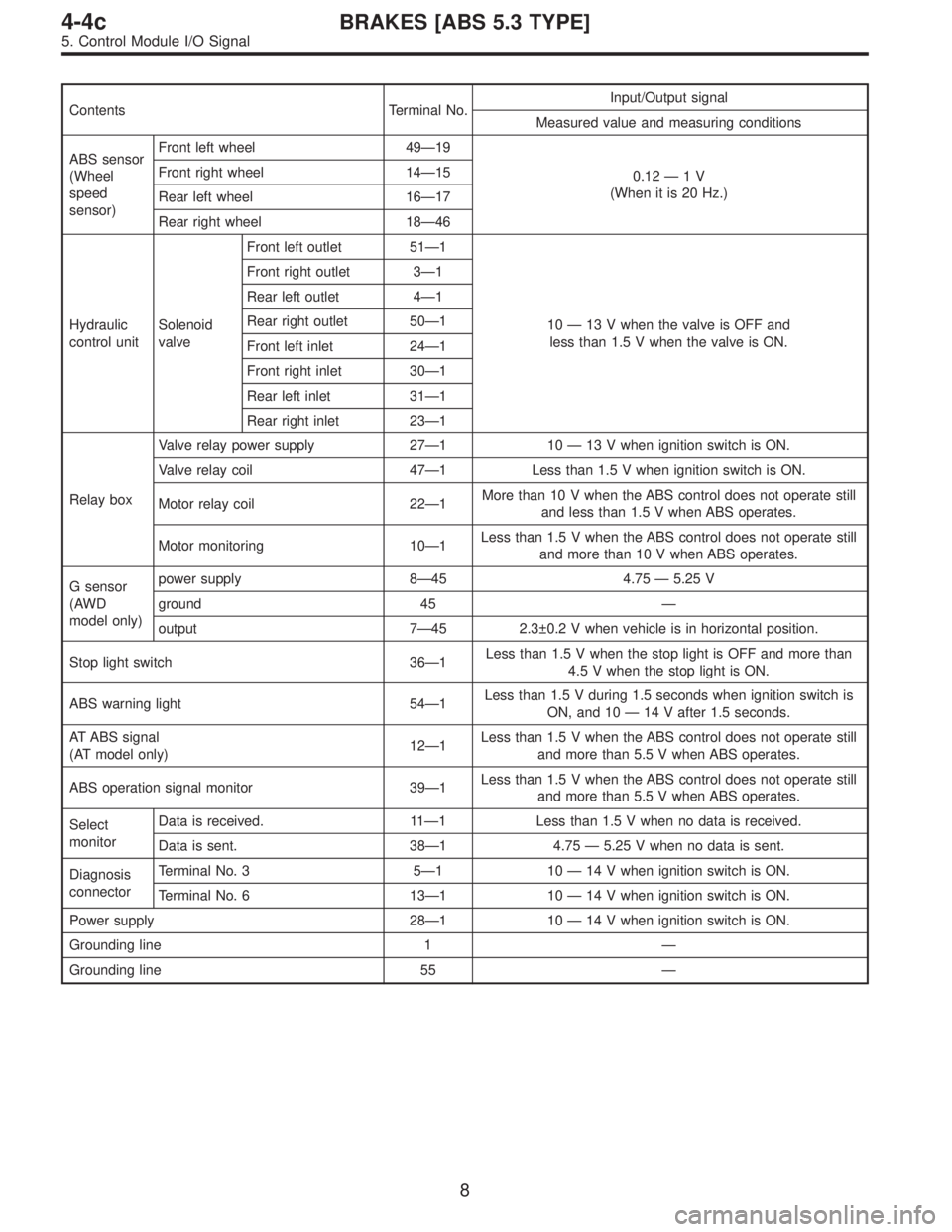
Contents Terminal No.Input/Output signal
Measured value and measuring conditions
ABS sensor
(Wheel
speed
sensor)Front left wheel 49—19
0.12—1V
(When it is 20 Hz.) Front right wheel 14—15
Rear left wheel 16—17
Rear right wheel 18—46
Hydraulic
control unitSolenoid
valveFront left outlet 51—1
10—13 V when the valve is OFF and
less than 1.5 V when the valve is ON. Front right outlet 3—1
Rear left outlet 4—1
Rear right outlet 50—1
Front left inlet 24—1
Front right inlet 30—1
Rear left inlet 31—1
Rear right inlet 23—1
Relay boxValve relay power supply 27—110—13 V when ignition switch is ON.
Valve relay coil 47—1 Less than 1.5 V when ignition switch is ON.
Motor relay coil 22—1More than 10 V when the ABS control does not operate still
and less than 1.5 V when ABS operates.
Motor monitoring 10—1Less than 1.5 V when the ABS control does not operate still
and more than 10 V when ABS operates.
G sensor
(AWD
model only)power supply 8—45 4.75—5.25 V
ground 45—
output 7—45 2.3±0.2 V when vehicle is in horizontal position.
Stop light switch 36—1Less than 1.5 V when the stop light is OFF and more than
4.5 V when the stop light is ON.
ABS warning light 54—1Less than 1.5 V during 1.5 seconds when ignition switch is
ON, and 10—14 V after 1.5 seconds.
AT ABS signal
(AT model only)12—1Less than 1.5 V when the ABS control does not operate still
and more than 5.5 V when ABS operates.
ABS operation signal monitor 39—1Less than 1.5 V when the ABS control does not operate still
and more than 5.5 V when ABS operates.
Select
monitorData is received. 11—1 Less than 1.5 V when no data is received.
Data is sent. 38—1 4.75—5.25 V when no data is sent.
Diagnosis
connectorTerminal No. 3 5—110—14 V when ignition switch is ON.
Terminal No. 6 13—110—14 V when ignition switch is ON.
Power supply 28—110—14 V when ignition switch is ON.
Grounding line 1—
Grounding line 55—
8
4-4cBRAKES [ABS 5.3 TYPE]
5. Control Module I/O Signal
Page 2367 of 2890
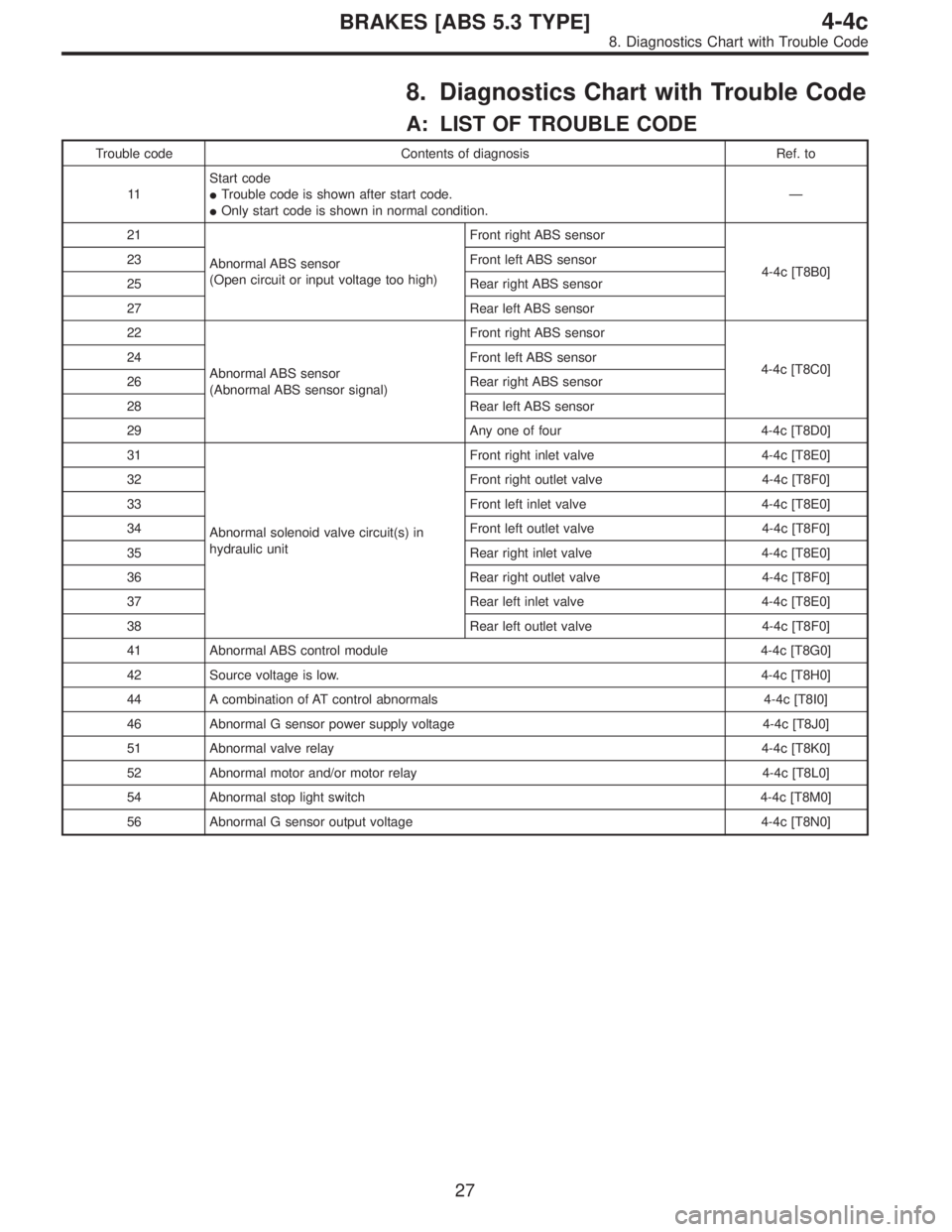
8. Diagnostics Chart with Trouble Code
A: LIST OF TROUBLE CODE
Trouble code Contents of diagnosis Ref. to
11Start code
�Trouble code is shown after start code.
�Only start code is shown in normal condition.—
21
Abnormal ABS sensor
(Open circuit or input voltage too high)Front right ABS sensor
4-4c [T8B0] 23 Front left ABS sensor
25 Rear right ABS sensor
27 Rear left ABS sensor
22
Abnormal ABS sensor
(Abnormal ABS sensor signal)Front right ABS sensor
4-4c [T8C0] 24 Front left ABS sensor
26 Rear right ABS sensor
28 Rear left ABS sensor
29 Any one of four 4-4c [T8D0]
31
Abnormal solenoid valve circuit(s) in
hydraulic unitFront right inlet valve 4-4c [T8E0]
32 Front right outlet valve 4-4c [T8F0]
33 Front left inlet valve 4-4c [T8E0]
34 Front left outlet valve 4-4c [T8F0]
35 Rear right inlet valve 4-4c [T8E0]
36 Rear right outlet valve 4-4c [T8F0]
37 Rear left inlet valve 4-4c [T8E0]
38 Rear left outlet valve 4-4c [T8F0]
41 Abnormal ABS control module 4-4c [T8G0]
42 Source voltage is low. 4-4c [T8H0]
44 A combination of AT control abnormals 4-4c [T8I0]
46 Abnormal G sensor power supply voltage 4-4c [T8J0]
51 Abnormal valve relay4-4c [T8K0]
52 Abnormal motor and/or motor relay 4-4c [T8L0]
54 Abnormal stop light switch 4-4c [T8M0]
56 Abnormal G sensor output voltage 4-4c [T8N0]
27
4-4cBRAKES [ABS 5.3 TYPE]
8. Diagnostics Chart with Trouble Code